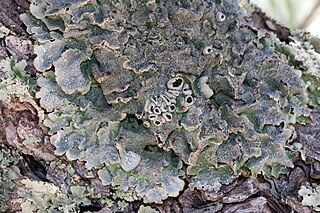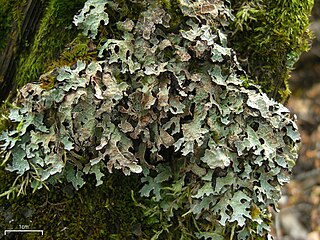
Hypogymnia is a genus of foliose lichens in the family Parmeliaceae. They are commonly known as tube lichens, bone lichens, or pillow lichens. Most species lack rhizines that are otherwise common in members of the Parmeliaceae, and have swollen lobes that are usually hollow. Other common characteristics are relatively small spores and the presence of physodic acid and related lichen products. The lichens usually grow on the bark and wood of coniferous trees.
Parmelia asiatica is a species of corticolous (bark-dwelling) foliose lichen in the family Parmeliaceae. It occurs in China and the Russian Far East, where it grows on Rhododendron tree trunks in temperate regions. It was Described as new to science in 2011 by lichenologists Ana Crespo and Pradeep Divakar. The species is distinguished by its terminal soralia, marginal linear pseudocyphellae, and chemical composition, which includes the substances atranorin and salazinic acid. Parmelia asiatica is similar to Parmelia protosulcata but differs in the presence of salazinic acid and its distribution in Southeast Asia.
Vermilacinia leonis is a fruticose lichen usually found on branches of shrubs in the fog regions along the Pacific Coast of North America and South America; in North America it is found on the southern half of the main peninsula of Baja California north to the southern coast of the Vizcaíno Peninsula. In South America, it occurs on bushes and rocks in Chile; reported from Colchaqua (Valley) and Santiago The epithet is in regard to absence of the black transverse bands often seen in other species such as V. leopardina, V. tigrina and V. zebrina.

Hypogymnia occidentalis, commonly known as the lattice tube lichen, is a species of foliose lichen in the family Parmeliaceae. It is found in North America, where it grows on the lower trunks of conifers, particularly Douglas-fir.
Hypogymnia diffractaica is a species of foliose lichen in the family Parmeliaceae. Initially reported from Southwest China, it was described as a new species by Bruce McCune in 2003. The type specimen was collected in Jiulong County, at an elevation of 3,000 metres (9,800 ft). Here it was found growing on the bark and wood of Rhododendron; it has also been recorded on birch. It is characterized by its slender lobes, the rimmed holes on the lower surface, and the presence of the chemical diffractaic acid as the main secondary metabolite in the medulla. It has a lower surface that is expanded and puffed out. Hypogymnia hengduanensis, the only other Hypogymnia species containing diffractaic acid as the main medullary substance, is quite similar in appearance, but can be distinguished from H. diffractaica by the presence of isidia. It also tends to grow at slightly lower elevations. In 2018, H. diffractaica was recorded from Bhutan.
Hypogymnia congesta is a rare species of foliose lichen in the family Parmeliaceae. Found in China, it was formally described as a new species in 2003. The lichen grows on the bark and wood of conifers and bamboo. Hypogymnia congesta has a brown to brownish-grey foliose thallus measuring up to 8 cm (3.1 in) long or broad, with a cartilage-like texture. The lichen is chemically distinct, containing physodic acid and virensic acid; the latter substance is otherwise unknown from genus Hypogymnia.

Punctelia hypoleucites, commonly known as the southwestern speckled shield lichen, is a species of foliose (leafy) lichen in the family Parmeliaceae. First formally described by Finnish botanist William Nylander as a species of Parmelia, it was transferred to the genus Punctelia in 1982. The lichen is found in Africa, North America, and South America, where it grows on the bark of both hardwood and coniferous trees. Its greenish-grey thallus is covered with tiny white pseudocyphellae – minute holes in the thallus surface that facilitate gas exchange. Some macroscopic features that help distinguish this species from other related members of the genus include the presence and the structure of the apothecia, the absence of asexual surface propagules, and the light brown color of the thallus undersurface. Chemically, the presence of lecanoric acid in the medulla and atranorin in the cortex help distinguish it from lookalikes.

Punctelia bolliana, the eastern speckled shield lichen, is a species of foliose lichen in the family Parmeliaceae. It is found in North America, with a distribution extending from the Canadian province of Ontario south to the central and northeastern United States and Mexico. It grows on the bark of both deciduous trees and coniferous trees. The combination of characteristics that distinguishes this species from others in genus Punctelia are the absence of the vegetative propagules isidia and soralia, a pale brown lower thallus surface, and the presence of the secondary chemical protolichesterinic acid in the medulla.

Hypogymnia krogiae, commonly known as the freckled tube lichen, is a species of foliose lichen in the family Parmeliaceae. Found in North America, it was described as a new species in 1973 by Karl Ohlsson. The type specimen was collected near Cheat Bridge, West Virginia by Mason Hale in 1956.

Hypogymnia flavida is a species of foliose lichen in the family Parmeliaceae. It is found in mountainous locations of east Asia, where it grows on the bark and wood of woody plants. It has a relatively large yellowish thallus.

Parmelia barrenoae is a species of foliose lichen in the large family Parmeliaceae. It was formally described as a new species in 2005. Before this, it was lumped together as one of several lichens in the Parmelia sulcata group—a species complex of genetically distinct lookalikes. Parmelia barrenoae is widely distributed, occurring in Europe, western North America, Africa, and Asia.

Parmelia fraudans is a species of foliose lichen in the family Parmeliaceae. It is found in Europe and North America, where it grows on rocks.
Hypogymnia papilliformis is a rare species of foliose lichen in the family Parmeliaceae. Found in China and the Russian Far East, it was formally described as a new species in 2015 by Bruce McCune, Svetlana Tchabanenko, and Xin Li Wei. The type specimen was collected by the second author in the Lazovsky Nature Reserve at an altitude of 600 m (2,000 ft); here, in a mixed conifer–broadleaved forest, it was found growing on Korean pine. The lichen has also been recorded from a mixed forest in the mountains of Shaanxi Province in China, at an altitude of 1,500 m (4,900 ft). The specific epithet papilliformis alludes to the papillose texture of the upper thallus surface. Secondary compounds that occur in Hypogymnia papilliformis include atranorin, and physodic acid as major metabolites, and minor amounts of 2'-O-methylphysodic acid and vittatolic acid.
Hypogymnia pruinoidea is a species of foliose lichen in the family Parmeliaceae. Found in China, it was formally described as a new species in 2012 by Xin-Li Wei and Jiang-Chun Wei. The type specimen was collected from Mt. Taibaishan (Shaanxi) at an elevation of 2,800 m (9,200 ft), where it was found growing on the trunk of Abies. It is only known to occur at this location, a cool and moist montane environment supporting lichen-rich forests and woodlands. The species epithet refers to the pruinose upper thallus surface and lobe tips.

Pseudevernia consocians is a species of lichen in the family Parmeliaceae. It is found in both North America and Central America. Some characteristic features of Pseudevernia consocians are its well-developed, numerous isidia, relatively narrow lobes, and the presence of the lichen product lecanoric acid.
Parmotrema marcellianum is a species of saxicolous (rock-dwelling), foliose lichen in the family Parmeliaceae. Found on the Galápagos Islands, it was formally described as a new species in 2019 by lichenologists Frank Bungartz and Adriano Spielmann. The type specimen was collected from Cerro Ventanas on Floreana Island at an altitude of 424 m (1,391 ft); there, it was found overgrowing pebbles on sun-, wind-, and rain-exposed ground. The species epithet honours the authors' colleague Marcelo Pinto Marcelli, "in recognition of his work on the lichen family Parmeliaceae".
Hypogymnia nitida is a species of foliose lichen in the family Parmeliaceae. It has a glossy dark brown upper surface and a strongly wrinkled, convoluted lower surface. Found in China, it was described as a new species in 2014.
Hypogymnia pendula is a rare species of foliose lichen in the family Parmeliaceae. It is characterised by its pendulous (hanging) growth form and distinct chemical composition.
Hypogymnia saxicola is a rare species of foliose lichen in the family Parmeliaceae. Found in Yunnan and Sichuan provinces of China, it forms delicate cushions on mossy rocks in subalpine regions. It is characterised by its slender, glossy brown lobes and unique chemistry.
Hypogymnia tenuispora is a rare species of foliose lichen in the family Parmeliaceae. Found in China's Yunnan province, it is characterised by its uniquely narrow ascospores and crowded lobes, which help distinguish it from other similar Hypogymnia species.








